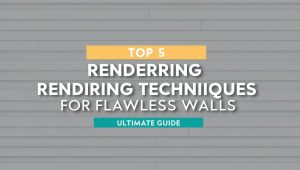Rendering is an essential part of creating smooth, flawless walls. Whether you’re working on a new build or renovating an older property, the right rendering technique can make a significant difference in the final look and durability of your walls. This post covers the top 5 rendering techniques to help you achieve the perfect finish, with insights on when to use each method and why they work so well.
1. Traditional Sand and Cement Rendering
Sand and cement rendering is the most common and cost-effective option for external walls. It involves mixing sand, cement, and water to create a thick paste that is applied to brick or block walls. The mixture is then smoothed over the surface to provide a strong and durable finish.
Advantages:
- Affordable and widely available.
- Provides a solid, long-lasting finish.
- Easy to apply for DIYers with basic skills.
While this technique is ideal for most general rendering jobs, it may not be the best choice for surfaces prone to movement or moisture. It also requires regular maintenance and resealing to prevent cracking. However, when properly applied, it provides an excellent foundation for decorative finishes.
Tips for success:
- Ensure that the surface is clean and free from dust before applying the render.
- Apply the mixture in thin layers to prevent cracking.
- Allow the render to cure slowly by keeping it moist for the first few days.
2. Acrylic Rendering
Acrylic rendering uses an acrylic polymer mixed with the sand and cement, which creates a more flexible and weather-resistant finish. It is particularly suitable for surfaces that need to withstand extreme temperatures or humidity.
Advantages:
- Highly durable and resistant to cracking.
- Flexible, making it ideal for buildings that experience movement.
- Offers a smooth, professional finish.
Acrylic render is typically applied in a single coat, which makes the process faster compared to traditional rendering. It is also available in a variety of colours and finishes, allowing for more aesthetic flexibility.
Tips for success:
- Work quickly to avoid streaks as acrylic render dries faster than other types.
- Use a spray gun or trowel to apply it for a smooth finish.
- Ensure proper surface preparation for maximum adhesion.
3. Monocouche Render
Monocouche render is a pre-mixed, one-coat render that is designed to provide a smooth finish without the need for multiple layers. It is often used on new builds due to its quick application and excellent durability.
Advantages:
- Quick application due to single-layer application.
- Available in a wide range of colours.
- Low-maintenance and weather-resistant.
Monocouche render is highly resistant to cracking, making it ideal for long-term protection of exterior walls. It provides excellent coverage and is more affordable than some other premium rendering techniques.
Tips for success:
- Apply monocouche render during dry weather conditions for optimal curing.
- Use a trowel or rendering machine to achieve a smooth finish.
4. Lime Rendering
Lime rendering is a traditional method often used in the restoration of historic or heritage buildings. Unlike cement-based renders, lime render allows the wall to “breathe,” preventing moisture from becoming trapped and causing damage over time.
Advantages:
- Ideal for older buildings, as it is breathable.
- Helps preserve the integrity of the structure.
- More environmentally friendly than cement render.
Lime render is perfect for properties that are vulnerable to moisture or those with sensitive materials. Its flexibility also helps prevent cracking in buildings that may settle or shift over time.
Tips for success:
- Lime render requires a longer curing time compared to other types, so be patient.
- Always apply in thin layers to ensure the best finish.
- Test the application on a small area first to check for compatibility.
5. Silicone Rendering
Silicone render is a newer, more advanced option that offers superior weatherproofing properties. It is highly resistant to water and dirt, making it ideal for homes in areas with heavy rainfall or humid climates.
Advantages:
- Water and dirt repellent.
- Excellent resistance to weathering.
- Minimal maintenance and cleaning required.
Silicone render is often applied over other base renders to provide additional protection. Its self-cleaning properties make it an excellent option for homes in areas prone to pollution or dirt accumulation.
Tips for success:
- Silicone render is best applied in warm, dry weather.
- Use a professional to ensure it’s applied correctly for maximum performance.
Conclusion
Each of these top 5 rendering techniques provides a different set of benefits, so choosing the right one depends on your specific needs. Whether you’re aiming for a smooth, weather-resistant finish or seeking a flexible, breathable option for a heritage building, there’s a perfect render for every project. Make sure to consider the environmental factors, the type of building you’re working on, and the aesthetic you wish to achieve before making your choice.



